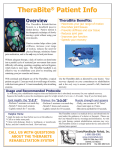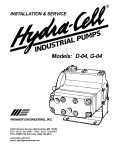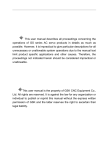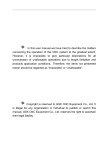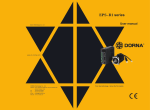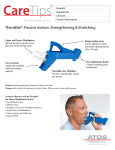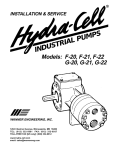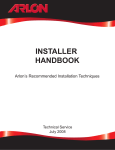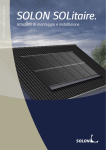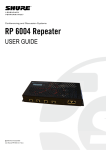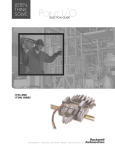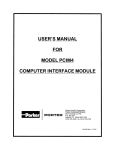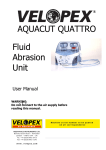Download Quick Reference Guide - TheraBite Jaw Rehabilition System now on
Transcript
TheraBite Jaw Motion Rehabilitation System Quick Reference Guide (NB: For use in UK & ROI only) NB: This Quick Reference Guide does not replace nor does it set forth the complete contents of the User Manual for the TheraBite® Jaw Motion Rehabilitation System™, and is not a substitute for reviewing and understanding that important information. Therefore, before using the TheraBite® Jaw Motion Rehabilitation System™, please review the entire contents of the User Manual that is supplied with the product. Product description [Fig. 1-5] The TheraBite® Jaw Motion Rehabilitation System™ consists of: • The Jaw Mobilizer (1 pc) [Fig. 1] including the following parts: a. Fine Adjustment Knob [Fig. 1a] b. Lever [Fig. 1b] c. Range Setting Arm [Fig. 1c] d. Upper Mouthpiece [Fig. 1d] e. Lower Mouthpiece [Fig. 1e] Fig.1 Fig.1 B C D E A • Bite Pad (4 pcs) [Fig. 2] • Fig.2 2 Fig. • Fig.3 3 Fig. Range of Motion Scale (30 pcs) [Fig. 4] • Fig.4 Fig.4 • User Manual (1 pc) Hand-Aid (1 pc) [Fig. 3] Carrying Bag (1 pc) [Fig. 5] Fig.5 5 Fig. • Patient Progress Log (1 pc) CAUTION: The components of the jaw mobilizer are not detachable. Any attempt to detach the parts e.g. the mouthpieces, can weaken the device and cause failure under load. Quick Reference Guide - For use in UK & ROI Only How does the TheraBite® system work? The TheraBite® system is a hand-operated system with adjustable range that is designed to assist users to improve the range of motion and strength of the jaw. The jaw mobilizer is held in the hand during use, with the mouthpieces placed between the upper and lower front teeth. Pressure on the Lever, applied by the user, provides either opening force or resistance to closing. [Fig. 6] Fig.66 Fig. The TheraBite® system utilizes repetitive passive motion and stretching. The jaw mobilizer guides the mandible (lower jaw) along an anatomically correct, curved pathway during opening and closing movements. [Fig. 6] The TheraBite® system can help achieve: 1. Proper jaw opening: • by stretching connective tissues • by mobilizing joints • by strengthening muscles across their full range of motion 2. Reduction in pain and inflammation • Passive mobilization of the joint Research has indicated that mobilization is beneficial in the management of joint disorders. Motion is necessary to prevent the degeneration of cartilage, the layer of tissue that lines most of the joint surfaces. In many cases, movement may stimulate joint healing and reduce pain and swelling. By stretching and relaxing muscles, gradual mobilization exercises can help individuals with muscle pain to improve their range of motion. Passive motion can also provide therapeutic advantages, especially following an operation. Quick Reference Guide - For use in UK & ROI Only INSTRUCTIONS FOR THE CLINICIAN Setting Maximum Opening of the Jaw Mobilizer [Fig. 7-8] Maximum openings of approximately 25 to 45 millimeters can be set by the position of the Range Setting Arm. [Fig. 7] • • • Fig.7 Fig.14 Hold the device on its side and apply very gentle pressure to the Lever – not enough to move the Lower Mouthpiece. Use a pointed object (such as a pen or pencil) to push out the pin that connects the Range Setting Arm to the Lever. [Fig. 8a & 8b] Align the Range Setting Arm in the desired position and replace the pin. (Range change is approximately 5 mm per interval.) 25mm 30mm 35mm 40mm 45mm Fig.15a Fig.8a Fig.15b Fig.8b The TheraBite® system can be used without adjusting these settings, depending on the patient’s ability to understand and implement instructions for the application of appropriate pressure. The millimeter scale on the jaw mobilizer is for patient reference only. Use the range of motion scale for more accurate measurement How to use the TheraBite® system How to put on the Bite Pads [Fig. 9a-9b] Fig.7 Fig.9a Fig.8 Fig.9b The TheraBite® system comes with self-adhesive bite pads to protect the user’s teeth. The clinician may, in the exercise of his or her independent clinical judgment, stack or trim the bite pads for extra protection. Peel off the backing to expose the sticky surface. [Fig. 9a] • Attach one bite pad to the Upper Mouthpiece and one to the Lower Mouthpiece. [Fig. 9b] • Apply pressure with your thumb or similar means to ensure sufficient initial adhesion to the mouth- pieces. Pressure and warmth under a prolonged period will make the bite pads tackier. Quick Reference Guide - For use in UK & ROI Only To enhance adhesion of the bite pads to the mouthpieces, apply the bite pads to the mouthpieces before going to bed and leave them on overnight. The adhesive bond created by the pressure-sensitive adhesive on the bite pads increases with time, such that the longer the bite pads sit on the mouthpieces prior to using the device, the more strongly they will tend to adhere. If the bite pads become worn, replace them with the two extra bite pads that are included with the TheraBite® system. For individuals with no teeth (edentulous) or a limited number of teeth, bite pads with thick cushioning for customized trimming can be ordered separately. bite pads for paediatric use are provided with the TheraBite® system for children. Additional bite pads can also be ordered separately. CAUTION: bite pads or parts of bite pads that become loose during use might obstruct breathing. Therefore make sure that the bite pads are securely attached to the mouthpieces after trimming and bonding. How to use the Jaw Mobilizer [Fig. 6] Hold the jaw mobilizer with the Lever up and with the mouthpieces inside your mouth. Squeeze the Lever gently to move the Lower Mouthpiece downward, following the natural motion of the jaw. Fig.6 Fig.6 How to use the Fine Adjustment Knob [Fig. 10] The Fine Adjustment Knob can be used to slow or stop the motion created by the jaw mobilizer. • Turn the knob all the way in (counter/anti-clockwise) to stop the Lever in the highest position. [Fig. 10a] • While squeezing gently, turn the knob out (clockwise) to allow the lower mouthpieces to move down slowly. [Fig. 10b] • The Lever may be released at any time without turning the Fine Adjustment Knob. Fig.10a Fig.9a Fig.10b Fig.9b Quick Reference Guide - For use in UK & ROI Only How to use the Hand-Aid [Fig. 11] The hand-aid is a tool designed to hold the Lever down and maintain opening during stretching or isometric exercises. To install the Hand-Aid: • Hold the jaw mobilizer in your left hand, and loosen the Fine Adjustment Knob so that the Lever can be squeezed all the way down. • Take the hand-aid in your right hand with the narrow groove on top. • Squeeze the Lever down, and place the open side of the hand-aid over the lowest part of the Lever. [Fig. 11a] • Rotate the hand-aid one-quarter turn clockwise, so that the handle groove is over the handle, and release the squeeze. • To use, slide the hand-aid towards the mouth. [Fig. 11b] • To release, push the hand-aid away. Fig.10a Fig.11a Fig.10b Fig.11b How to use the Range of Motion Scale [Fig. 12 & 13] The range of motion scale is designed to make mandibular motion measurement quick and easy. An area to record your progress is printed on the reverse side of the scale and a progress log comes with your device to track your progress. To measure the Maximal Incisal Opening (MIO) [Fig. 12]: • Open your mouth as widely as possibly without discomfort. • Place the range of motion scale so that the notch rests on the edge of a lower incisor (tooth). • Rotate the range of motion scale until it contacts an upper incisor. • Take the reading at the point of contact. • Record the measurement on the reverse side of the range of motion scale or in the separate patient progress log. Fig.11 Fig.12 Quick Reference Guide - For use in UK & ROI Only To measure Lateral Movement [Fig. 13]: • Rest the range of motion scale against the lower incisors with the teeth in gentle occlusion (the upper and lower teeth close together). • Align the arrow with an interproximal space (space between two upper teeth). [Fig. 13a] • Move the mandible laterally (side-to-side), and read the measurement on the Lateral Scale opposite the new position of the space. [Fig. 13b & 13c] • Record your progress on the reverse side of the range of motion scale or in the separate patient progress log. Fig.13a Fig.12a Fig.13b Fig.12b Fig.13c Fig.12c Getting started [Fig. 14] Adjust the Fine Adjustment Knob so that the Lever moves freely. Let the Lever come all the way up. • Hold the jaw mobilizer in the hand most comfortable for you. • Relax and open your mouth. • Place the mouthpieces between your upper and lower teeth, inside your lips. [Fig. 14a] • Your front teeth should just touch the inside rim of the Upper Mouthpiece. • Be careful to hold the jaw mobilizer level. Gently squeeze the Lever to push the Lower Mouthpiece down against your lower teeth. [Fig. 14b] • Release s e at any time by relax i ng you r hand. [Fig. 14c] Fig.14a Fig.13a Always begin and end each session by recording your beginning and ending measurements in the patient progress log. This will give you an accurate assessment of your progress, and will guide your clinician in directing your treatment. Fig.14b Fig.13b Fig.13c Fig.14c Quick Reference Guide - For use in UK & ROI Only Care and cleaning Use soap/detergent and water to clean the TheraBite® system. Rinse well, shake off excess water, and dry. The range of motion scale is a disposable product, which should not be cleaned. After cleaning the device, examine the bite pads on the Upper and Lower Mouthpiece and replace them if necessary. Replace bite pads only after ensuring that the mouthpieces are dry. Caution: The mouthpieces are made of a material that tends to retain moisture. Therefore, do not attempt to use the jaw mobilizer until the mouthpieces are dry of all moisture. Do not soak the device in any liquid. Damage to the unit may result if force is applied to mouthpieces that are wet. Caution: Avoid using a dishwasher to clean the TheraBite® system. Prolonged cleaning with a dishwasher may weaken the bonding of the mouthpieces or cause discoloring. Caution: Do not steam autoclave or gas autoclave the TheraBite® system. Sterilization processes may weaken the bonding of the mouthpieces and cause failure under load. Daily use It is very important that the rehabilitation program recommended by your clinician is followed on a regular basis. To help you maintain your rehabilitation program, whether at work, while traveling, or at play, a Carrying Bag is included with the TheraBite® system. The Carrying Bag is designed to keep all the components and accessories of the TheraBite® system together. The Carrying Bag also has room for tissues and other convenient items. Be sure to take the TheraBite® system with you wherever you go and continue your rehabilitation program at regular intervals during both work and recreation, as your clinician has advised. Do not miss a session! Always measure and record the opening of your mouth before and after each session, using the range of motion scales and the patient progress log. Rehabilitation programs for the TheraBite® system All users should receive adequate advice and instruction, as well as a personalized rehabilitation program, from their clinicians prior to using the TheraBite® system. All rehabilitation programs should include regular monitoring, review, and evaluation by a properly trained clinician. A commonly used exercise regimen is 7-7-7: Seven times per day. Seven stretches each time. Each stretch held for seven seconds. Individuals who suffer from muscle and/or joint pain may also benefit from longer stretch exercises in their rehabilitation programs. An exercise regimen with longer stretches is 5-5-30: Five times per day. Five stretches each time. Each stretch held for 30 seconds. After having used the TheraBite® system for several months, you may be able to reduce your exercise regimen. Consult your clinician before making any changes to your rehabilitation program and/or exercise regimen. Quick Reference Guide - For use in UK & ROI Only Rehabilitation program for wider jaw opening Stretching program • Place properly cushioned mouthpieces between your teeth. • Following the instructions of your clinician, slowly squeeze the Lever to open the mouthpieces. (Do not bite on the mouthpieces!) • • • • Allow your jaw to follow along with the motion of the mouthpieces. (Be careful not to tilt the jaw mobilizer up or down as you squeeze. Tilting may cause your jaw to move incorrectly.) Hold open as long as instructed by your clinician. Relax the squeeze, allowing your mouth to slowly close. Rest and repeat as instructed. If you find it difficult to hold the mouthpieces open, you may wish to use the hand-aid. A very slow opening motion may help to reduce pain or discomfort and may help to avoid muscle spasm. For slow opening: • Turn the Fine Adjustment Knob all the way in (counter/anti-clockwise). • Gently squeeze the Lever with one hand while turning the Fine Adjustment Knob outward (clockwise) with the other hand. • Continue to open until you have reached the limit prescribed. • Relax, rest, and repeat. Rehabilitation program to gain strength Resisted Movement • Insert the Mouthpieces and squeeze until you reach the opening recommended by your clinician. • Without releasing the Lever, bite against the mouthpieces. • Slowly release the Lever, allowing your mouth to close against the hand pressure. Your clinician will advise you how hard to squeeze while closing. • Rest briefly, then repeat. Rehabilitation program to develop coordination Reeducation The anatomically correct motion of the jaw mobilizer helps to train your jaw to move naturally. • Insert the mouthpieces and bite very gently. • Open your mouth while squeezing the Lever just hard enough to keep your teeth lightly touching the bite pads. • After opening as wide as you comfortably can, release the Lever slowly and close, still keeping your teeth in contact with the bite pads. • Repeat as often as instructed by your clinician so that your jaw muscles are trained to move correctly. Quick Reference Guide - For use in UK & ROI Only Prescription Information The availability of this device with or without prescription may vary from country to country. The TheraBite Jaw Motion Rehabilitation System is available on prescription in the UK Name Pack Ref Pip Code TheraBite® Device, Adult (incl bite pads and all accessories) 1 TH001 366-2020 TheraBite® Device, Paediatric (incl bite pads and all accessories) 1 TH002 366-2012 TheraBite® Replacement Bite Pads, Adult 4pcs PA001 366-2004 TheraBite® Replacement Bite Pads, Adult Edentulous 4pcs PA002 366-1998 TheraBite® Replacement Bite Pads, Paediatric 4pcs PA003 366-1980 Platon Medical Ltd. PO Box 2568, Eastbourne, East Sussex, BN21 1HU Tel: 01323 431930 Fax: 01323 732606 [email protected] www.platonmedical.co.uk © Platon Medical 2011 ref:TBUG0911. TheraBite® is a registered trademark owned by AtosMedical AB, Sweden TheraBite is manufacturerd by Atos medical AB, Kraftgatan 8, PO Box 183 SE-242 22 Horby Sweden










